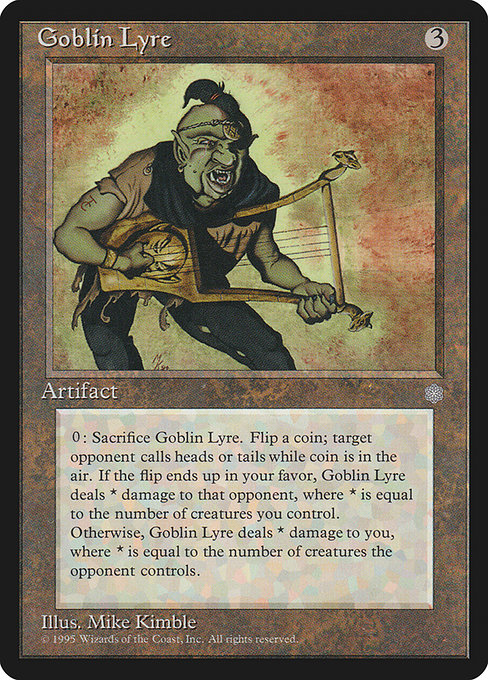
Image courtesy of Scryfall.com
Hidden Symbolism in Goblin Lyre Artwork
Magic: The Gathering’s Goblin Lyre is more than a quirky artifact with a coin-flip twist. Painted into the Ice Age era by Mike Kimble, this rare artifact invites us to read its art as a compact story: a goblin focal point, a musical instrument that doubles as a fuse for chaos, and a mise-en-scène that hints at luck, risk, and consequence. While the card’s text is famously crisp—“Sacrifice this artifact: Flip a coin. If you win the flip, this artifact deals damage to target opponent or planeswalker equal to the number of creatures you control. If you lose the flip, this artifact deals damage to you equal to the number of creatures that opponent or that planeswalker’s controller controls.”—the imagery speaks a parallel language about fate and choice. 🧙♂️🔥
The lyre itself—an emblem of harmony in many mythologies—here becomes a symbol of volatile opportunity. In goblin culture as imagined by Ice Age-era design, music, misdirection, and a surprising spark of chaos often mingle in equal measure. The goblin’s grin, the instrument’s gleam, and the surrounding clutter of artifacts and sparks whisper a universe where every musically tuned note could detonate into a game-changing moment. That tension between beauty and risk is the heartbeat of Goblin Lyre’s hidden symbolism. 🎨
The coin flip as a cultural lens
The centerpiece of the card—flipping a coin—reads like a carnival mirror held up to the tabletop world. Coins symbolize chance, cryptic fate, and a gambler’s swagger. In the context of Goblin Lyre, the coin flip becomes a microcosm of how goblins approach competition: bold bets, high variance, and the thrill of “what if?” If you win, your chorus of creatures delivers a fiery crescendo to your opponent’s plans; if you lose, the mirror cracks and you pay for overreaching with damage to yourself proportional to your adversary’s strength. The artistry nudges players to feel the risk—every flip is a moment where music and mayhem intersect. 🎲⚔️
The Ice Age era itself was a time of experimentation and rapid design shifts in Magic’s early days. Goblin Lyre’s unassuming colorless identity underscored the era’s fascination with artifact-centric strategies. The artwork’s composition reinforces that theme: a device meant to be “played” becomes a volatile engine of consequence. In a world where tempo matters as much as raw power, the Lyre’s coin flip becomes a narrative device—a story beat that asks, “Do you lean into risk for explosive payoff, or respect the ledger of potential self-damage?” This is where the piece penetrates beyond flavor text and becomes a meditation on risk management in both games and life. 🧙♂️💎
Visual motifs and design language
Mike Kimble’s illustration blends the rough edges of Goblin aesthetics with a surprisingly delicate lyre. The juxtaposition—gaudy goblin innovation meeting a refined musical instrument—mirrors the card’s gameplay: a crafted artifact that can swing a game on a single, capricious flip. The surrounding artifacts and muted color palette of Ice Age set a mood of ancient forge-work and underground showmanship. The visual rhythm encourages players to imagine a moment when a goblin’s melody becomes the spark that lights a battlefield-wide chain reaction. It’s a reminder that in MTG, art and mechanics often share a common language: balance between opportunity and risk, beauty and danger. 🎨🧪
Strategy notes for modern singletons and nostalgia decks
Goblin Lyre is a colorless, three-mana artifact with a defining risk-reward mechanic. In today’s larger card pool, it shines most when you pair it with strategies that maximize creature count or take advantage of large, intimidating boards. If you can stack the battlefield with creatures before you flip, a successful call can yield big damage to an opponent or their planeswalker—until fate flips the other way and you sustain the fire. In a casual or Commander setting, Goblin Lyre invites inventive synergies: token generators, mass-creature buffs, and cards that transform risk into reward. The lamp of luck shines brightest when you’ve got ways to flood the board, or when your deck embraces a little chaos as a feature rather than a bug. And because it’s a legacy- and vintage-legal artifact, it still has a place in certain meta-space where artifact-light engines swing into action. For collectors, the Ice Age rarity and the art’s enduring appeal keep Goblin Lyre a charming relic of a formative era in MTG’s art direction. 💥🧙♂️
As a design artifact, Goblin Lyre teaches a broader lesson: the most memorable cards aren’t just about numbers on a page, but about the stories those numbers tell. The coin flip becomes a ritual, the lyre a conduit for narrative drama, and the goblin a maestro of mischief—reminding us that even in a world of battles and banter, artistry and chance walk hand in hand. If you’re building a deck that loves a dramatic swing, or you’re simply revisiting Ice Age’s iconic moment, Goblin Lyre remains a small, glittering hinge on which the door to a memorable game can swing. 🧙♂️🎲
Neon Phone Case with Card Holder Glossy Matte Polycarbonate MagSafeMore from our network
- https://blog.digital-vault.xyz/blog/post/foundry-helix-rarity-and-print-distribution-explored/
- https://transparent-paper.shop/blog/post/accessibility-in-digital-product-design-a-practical-guide/
- https://transparent-paper.shop/blog/post/crafting-digital-planners-that-customers-truly-love/
- https://crypto-acolytes.xyz/blog/post/ai-generated-survival-worlds-in-crypto-gaming/
- https://crypto-acolytes.xyz/blog/post/cross-border-identity-verification-in-web3-compliance-and-privacy/